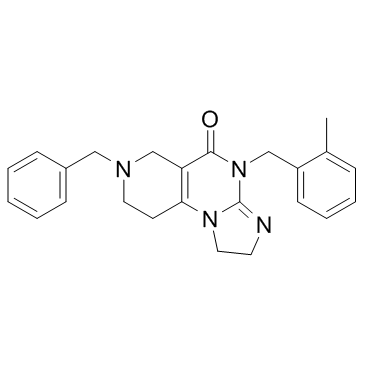1616632-77-9
| Name | TIC10 |
|---|---|
| Synonyms |
Imidazo[1,2-a]pyrido[3,4-e]pyrimidin-5(1H)-one, 2,4,6,7,8,9-hexahydro-4-[(2-methylphenyl)methyl]-7-(phenylmethyl)-
7-Benzyl-4-(2-methylbenzyl)-2,4,6,7,8,9-hexahydroimidazo[1,2-a]pyrido[3,4-e]pyrimidin-5(1H)-one TIC10 |
| Description | TIC10 is a potent, orally active, and stable TRAIL inducer, also inhibits Akt and ERK activity. |
|---|---|
| Related Catalog | |
| Target |
TRAIL Akt ERK |
| In Vitro | TRAIL-inducing compound 10 (TIC10), a potent, orally active, and stable small molecule that transcriptionally induces tumor necrosis factor-related apoptosis-inducing ligand (TRAIL) in a p53-independent manner and crosses the blood-brain barrier. TIC10 induces a sustained up-regulation of TRAIL in tumors and normal cells that may contribute to the demonstrable antitumor activity of TIC10. TIC10 inactivates kinases Akt and extracellular signal-regulated kinase (ERK), leading to the translocation of Foxo3a into the nucleus, where it binds to the TRAIL promoter to up-regulate gene transcription. TIC10 is an efficacious antitumor therapeutic agent that acts on tumor cells and their micro-environment to enhance the concentrations of the endogenous tumor suppressor TRAIL. TIC10 as a TRAIL-inducing compound. TIC10 causes a dose-dependent increase in TRAIL mRNA and induces TRAIL protein localization on the cell surface of several cancer cell lines in a p53-independent manner. Besides, both pAkt and pERK are down-regulated by TIC10 treatment in a dose-dependent manner. TIC10 also causes a down-regulation of the total expression of ERK[1]. |
| In Vivo | In DLD-1 colon cancer xenografts, TIC10 induces tumor stasis at 1 week after treatment, whereas TRAIL-treated tumors progress after a single dose. A single dose of TIC10 also induces a sustained regression of the SW480 xenograft and is equally effective when delivered by intraperitoneal or oral route, suggesting favorable oral bioavailability for TIC10. Titration of a single oral dose of TIC10 in the HCT116 xenograft model reveals sustained antitumor efficacy at 25 mg/kg. Exposure to oral TIC10 at 25 mg/kg weekly for 4 weeks in immunocompetent mice does not cause any changes in selected serum chemistry markers. The same oral dosing schedule is applied to Eμ-myc transgenic mice, which spontaneously develop meta-static lymphoma from weeks 9 to 12 of age, and TIC10 significantly (P=0.00789) prolongs the survival of these mice by 4 weeks[1]. |
| Cell Assay | Floating and adherent cells are analyzed on a Coulter-Beckman Elite Epics cytometer. For surface TRAIL experiments, adherent cells are harvested by brief trypsinization, fixed in 4% paraformaldehyde in phosphate-buffered saline (PBS) for 20 min, incubated with an anti-TRAIL antibody at 1:250 overnight, washed and incubated with anti-rabbit Alexa Fluor 488 for 30 min, and analyzed. Cells are gated on forward and side scatter to eliminate debris and dead cells from the analysis. Surface TRAIL data are expressed as median fluorescence intensity relative to that of control samples unless indicated otherwise. Surface DR5 is analyzed similarly with an antibody from Imgenex. For sub-G1content and cell cycle profile analysis, all cells are pelleted and ethanol-fixed, followed by staining with propidium iodide in the presence of RNase. Cell viability assays are carried out in 96-well black-walled clear-bottom plates with CellTiter-Glo[1]. |
| Animal Admin | Mice[1] For subcutaneous xenografts, 4- to 6-week-old female athymic nu/nu mice are inoculated with 1×106 cells (2.5×106 for T98G) of the indicated cell lines in each rear flank as a 200-μL suspension of 1:1 Matrigel (BD)/PBS. All subcutaneous tumors are allowed to establish for 1 to 4 weeks after injection until reaching a volume of ~125 mm3 before treatment initiation. All intraperitoneal and intravenous injections are given at a total volume of 200 μL. Oral formulations of TIC10 are administered by oral gavage and given as a 200 μL suspension containing 20% Cremophor EL, 10% DMSO, and 70% PBS. Tumors are monitored with digital calipers at indicated time points. All subcutaneous tumors are allowed to establish for 1-4 weeks post-injection until reaching a volume of ~125 mm3 before treatment initiation. Relief of tumor burden is monitored for 3 weeks after disappearance of the tumor and confirmed by visual inspection after euthanasia. |
| References |
| Density | 1.2±0.1 g/cm3 |
|---|---|
| Boiling Point | 559.7±60.0 °C at 760 mmHg |
| Molecular Formula | C24H26N4O |
| Molecular Weight | 386.489 |
| Flash Point | 292.3±32.9 °C |
| Exact Mass | 386.210663 |
| LogP | 3.14 |
| Vapour Pressure | 0.0±1.5 mmHg at 25°C |
| Index of Refraction | 1.672 |
| Storage condition | -20℃ |
